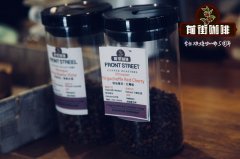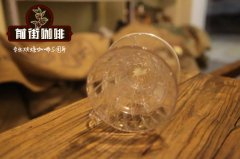Yemeni Mocha Fine Coffee Bean production area introduces the planting history of coffee bean varieties in the producing area

Professional coffee knowledge exchange more coffee bean information please follow the coffee workshop (Wechat official account cafe_style)
Yemeni mocha boutique coffee bean Matari Mattari growing history? Flavor and taste characteristics?
Origin & # 39; Manor Matari, Yemen
Geographical environment of production: above 1400 meters above sea level
Treatment: insolation
Taste special: full acidity, strong stimulation, more prominent than the fruit, with the perfect depth and concentration. When the coffee cools, it has a hint of fruit and chocolate.
Until the sixth century AD, Yemen was called Arab, so coffee trees shipped from Yemen to other places were also called Arabian coffee trees. The origin of these trees is Ethiopia (Ethiopia), and the Dutch spread these coffee trees all over the world. Dutch businessmen heading eastward around the Cape of good Hope began to make a long journey.
Before wading to India, you have to pass through the east coast of Africa to the port of Mocha in Yemen. In 1696 the Dutch introduced the coffee tree to Ceylon (now Sri Lanka) and then to Batavia in Java. Mocha beans are smaller and rounder than most, which makes mocha beans look like peas-in fact, bean-shaped berry coffee beans (Peaberry bean) are sometimes called mocha beans. Mocha beans are similar to Ethiopian Harrar beans in shape, with small particles, high acidity and a hint of chocolate, so the attempt to add chocolate to coffee is a natural development. In Yemen, coffee growers plant poplars to provide shade for coffee trees to grow. As in the past, these trees are planted on steep terraces to maximize the use of less rainfall and limited land resources. In addition to Tibica and bourbon coffee trees, more than a dozen different coffee species native to Ethiopia are grown in Yemen. However, even the best coffee, such as premium mocha, is air-dried and the peel is connected to the beans. Until now, traditional stone mills are often used to remove dry and hard shells, which makes the shape of coffee beans very irregular and often damages them. Despite the high quality and smooth aroma of Yemeni coffee, there is something unsatisfactory, that is, the quality can not be continuously guaranteed, and the classification of its coffee beans is uncertain. Traditionally, the best coffee beans in Yemen come from Mattari, followed by Sharki, followed by Sanani. These producing areas are treated by the sun, so the coffee beans have a wild flavor. Generally speaking, Yemeni coffee has a unique character, wild, complex and exciting, especially the charming sour wine and deep dark chocolate flavor. These beans are low in caffeine and are exported from December to April of the following year. The problem in the past has been that coffee from the north was mixed with shoddy stuff before it was shipped from the southern port of Aden. Only coffee shipped from the port of Hodeida can be determined to come from the north.
How to cook Yemeni mocha?
1. Filter cup: V60
two。 Water temperature: 88 degrees
3. Degree of grinding: small Fuji degree of grinding 4
4. Baking degree: medium baking
5. Steaming time: 25 seconds
Flavor: balanced, chocolate, long-lasting caramel sweetness
Qianjie Coffee suggestion: 15g powder, 4 grinding of small Fuji ghost tooth cutter, V60 filter cup, 88-89 degrees water temperature, 30g water injection for the first time, 25 s steaming, water injection to 104g water cut off, wait for the amount of water in the powder bed to go down to half and then water injection, slow water injection until 220g water, 5 grams at the end, no water powder ratio at 1:15, extraction time about 2:00 (calculated after stewing)
Related recommendation: what is mocha coffee? Yemeni mocha-Matali sun beans are the real mocha coffee beans in Yemen
Important Notice :
前街咖啡 FrontStreet Coffee has moved to new addredd:
FrontStreet Coffee Address: 315,Donghua East Road,GuangZhou
Tel:020 38364473
- Prev

Yemeni mocha supreme Shirazi origin introduction of Yemeni mocha supreme Shirazi origin flavor
For more information on coffee beans, please follow the coffee workshop (Wechat official account cafe_style). In fact, Yemen is located on the Arabian Peninsula of the Asian continent, but it is very close to Africa as long as it crosses the Red Sea and the Gulf of Aden Gulf of Aden. However, other Arab countries do not produce coffee, so people classify Yemeni coffee as North African coffee.
- Next

A list of the main producing areas of Ethiopian Coffee not only Yega Xuefei
Professional coffee knowledge exchange more coffee bean information please follow the coffee workshop (Wechat official account cafe_style) Ethiopia is known as the birthplace of coffee, it is a local custom, no matter how poor people's homes, they must have a coffee pot and a charcoal stove, why? Because coffee is something that local people think they have to make every day.
Related
- Does Rose Summer choose Blue, Green or Red? Detailed explanation of Rose Summer Coffee plots and Classification in Panamanian Jade Manor
- What is the difference between the origin, producing area, processing plant, cooperative and manor of coffee beans?
- How fine does the espresso powder fit? how to grind the espresso?
- Sca coffee roasting degree color card coffee roasting degree 8 roasting color values what do you mean?
- The practice of lattes: how to make lattes at home
- Introduction to Indonesian Fine Coffee beans-- Java Coffee producing area of Indonesian Arabica Coffee
- How much will the flavor of light and medium roasted rose summer be expressed? What baking level is rose summer suitable for?
- Introduction to the characteristics of washing, sun-drying or wet-planing coffee commonly used in Mantenin, Indonesia
- Price characteristics of Arabica Coffee Bean Starbucks introduction to Manning Coffee Bean Taste producing area Variety Manor
- What is the authentic Yega flavor? What are the flavor characteristics of the really excellent Yejasuffi coffee beans?

